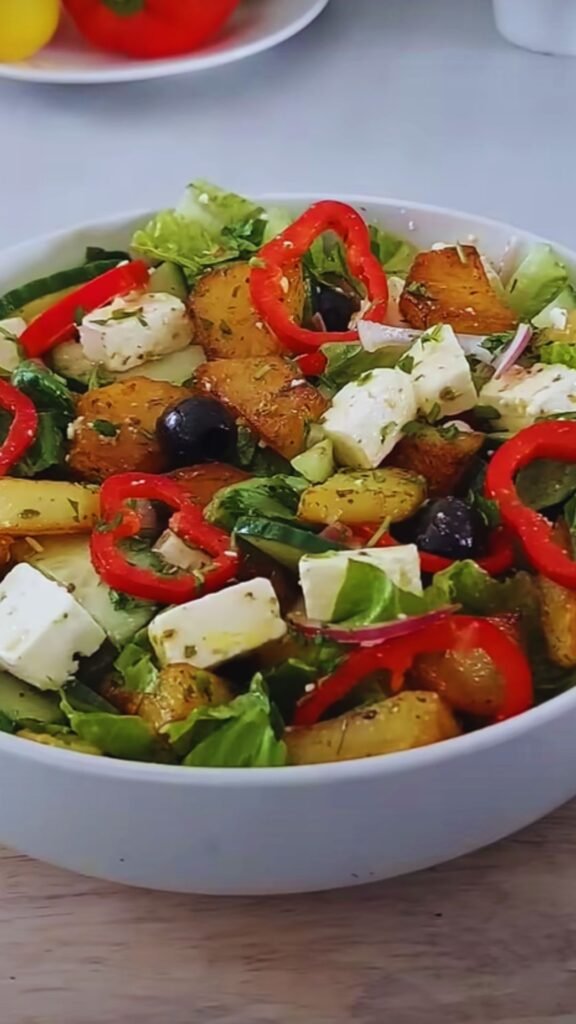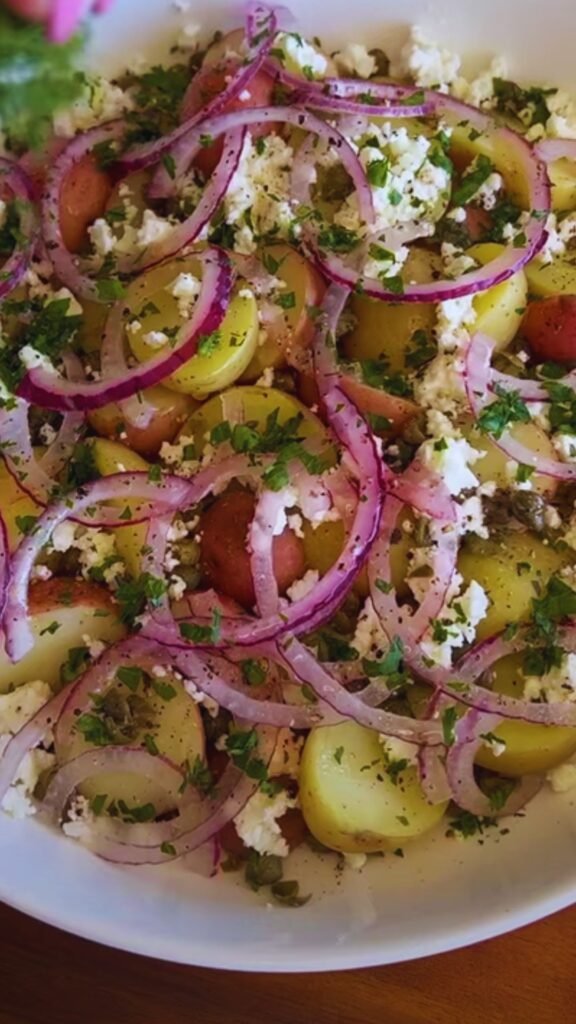There’s something about the combination of tender potatoes, briny olives, and tangy feta cheese that makes my heart sing. Greek potato salad has become my go-to side dish whenever I’m craving something that’s both satisfying and refreshing. Unlike its mayonnaise-laden American cousin, this Mediterranean-inspired potato salad relies on olive oil, lemon juice, and herbs to create a bright, zesty flavor profile that pairs perfectly with grilled meats or stands proudly on its own.
I first discovered Greek potato salad during a summer vacation to Santorini. After a long day exploring the white-washed buildings and breathtaking caldera views, I stumbled upon a small family-owned taverna. The elderly proprietor recommended their potato salad, and with one bite, I was transported to potato heaven. I’ve spent years perfecting my version of this delightful dish, and today I’m sharing all my secrets with you.
What Makes Greek Potato Salad Different?
Greek potato salad stands apart from traditional American versions in several key ways:
- No mayonnaise – Instead, it features a light, zesty dressing made with extra virgin olive oil and lemon juice
- Mediterranean ingredients – Kalamata olives, feta cheese, and fresh herbs create an authentic Greek flavor profile
- Served at room temperature – This allows the flavors to fully develop and blend together
- Healthier profile – With heart-healthy olive oil and fresh vegetables, it’s a more nutritious alternative to conventional potato salads
The combination of these elements creates a potato salad that’s perfect for outdoor gatherings (no mayonnaise to spoil in the heat!), meal prep (it tastes even better the next day), and anyone looking to enjoy a lighter take on this classic side dish.
Ingredients You’ll Need
For the perfect Greek potato salad, quality ingredients make all the difference. Here’s what you’ll need to gather:
For the Salad Base:
- 2 pounds Yukon Gold potatoes (about 6-7 medium potatoes)
- 1 small red onion, thinly sliced
- 1 English cucumber, diced
- 1 pint cherry tomatoes, halved
- 1/2 cup Kalamata olives, pitted and halved
- 1/2 cup crumbled feta cheese
- 1/4 cup fresh dill, chopped
- 2 tablespoons fresh mint, chopped
- 2 tablespoons fresh parsley, chopped
For the Dressing:
- 1/3 cup extra virgin olive oil (use the best quality you can afford)
- 3 tablespoons fresh lemon juice
- 1 tablespoon red wine vinegar
- 2 cloves garlic, minced
- 1 teaspoon dried oregano
- 1/2 teaspoon Dijon mustard
- 1/2 teaspoon honey
- Salt and freshly ground black pepper, to taste
Potato Selection: The Foundation of Great Potato Salad

Choosing the right potato is crucial for creating the perfect Greek potato salad. Different varieties have varying starch contents and textures, which significantly impact the final dish. Here’s my breakdown of potato options:
| Potato Type | Starch Level | Texture When Cooked | Best For | Notes for Greek Salad |
|---|---|---|---|---|
| Yukon Gold | Medium | Creamy yet holds shape | All-purpose | My top choice – perfect balance of flavor and texture |
| Red Potatoes | Low | Firm, waxy | Salads, roasting | Excellent choice, holds shape beautifully |
| Russet | High | Fluffy, tends to fall apart | Mashing, baking | Avoid for Greek salad – too mealy |
| New Potatoes | Low | Firm, thin skin | Salads, roasting | Excellent choice, no peeling needed |
| Fingerling | Low | Dense, buttery | Salads, roasting | Fancy option with great flavor |
I always reach for Yukon Gold potatoes for my Greek potato salad. Their buttery flavor and medium starch content create the perfect texture – tender enough to absorb the dressing but firm enough to maintain their shape. Plus, their thin skins can be left on for added nutrition and a rustic appearance.
Step-by-Step Preparation
Creating the perfect Greek potato salad isn’t complicated, but attention to detail makes the difference between a good salad and a great one. Follow these steps for consistently delicious results:
Step 1: Prepare and Cook the Potatoes
- Wash your potatoes thoroughly under cold running water.
- If using Yukon Gold or new potatoes, you can leave the skins on (I recommend this for texture and nutrients). For other varieties, peeling is optional based on your preference.
- Cut potatoes into even, bite-sized chunks (about 3/4-inch cubes).
- Place potatoes in a large pot and cover with cold water by 1 inch.
- Add 1 tablespoon of salt to the water.
- Bring to a boil over medium-high heat, then reduce to a simmer.
- Cook until potatoes are easily pierced with a fork but still hold their shape, about 12-15 minutes (timing will vary based on potato variety and size).
- Drain thoroughly in a colander.
Pro tip: Starting potatoes in cold (not boiling) water ensures even cooking from the inside out.
Step 2: The Secret to Flavorful Potatoes
This is where my technique differs from most recipes, and it’s absolutely game-changing:
- Transfer the hot, drained potatoes to a large mixing bowl.
- While potatoes are still hot, drizzle them with 2 tablespoons of lemon juice and 2 tablespoons of olive oil.
- Sprinkle with 1/2 teaspoon salt and 1/4 teaspoon black pepper.
- Gently toss to coat (the hot potatoes will absorb the flavors like a sponge).
- Allow potatoes to cool to room temperature, tossing occasionally to ensure even flavor absorption.
This step is crucial because warm potatoes absorb flavors much more effectively than cold ones. You’ll notice a dramatic difference in the depth of flavor if you season your potatoes while they’re still hot.
Step 3: Prepare the Dressing
While the potatoes are cooling, prepare your dressing:
- In a small bowl or jar, combine the remaining olive oil, lemon juice, red wine vinegar, minced garlic, dried oregano, Dijon mustard, and honey.
- Add 1/2 teaspoon salt and 1/4 teaspoon freshly ground black pepper.
- Whisk vigorously until emulsified (or shake well if using a jar with a lid).
- Taste and adjust seasoning if needed.
The dressing should be bright and tangy with a good balance of acidity and richness from the olive oil.
Step 4: Assemble the Salad
Now comes the fun part – bringing all the elements together:
- To your bowl of cooled, seasoned potatoes, add the sliced red onion, diced cucumber, halved cherry tomatoes, and Kalamata olives.
- Pour the prepared dressing over everything.
- Add the chopped fresh herbs (dill, mint, and parsley).
- Gently fold everything together with a large spatula, being careful not to break up the potatoes.
- Finally, sprinkle the crumbled feta cheese on top and give the salad one final gentle toss.
Pro tip: Reserve a small amount of herbs and feta to sprinkle on top just before serving for a beautiful presentation.
Make-Ahead Tips and Storage

One of the best things about Greek potato salad is that it actually improves with time as the flavors meld together. Here’s how I handle make-ahead preparation and storage:
Make-Ahead Options:
- 24 hours ahead (best option): Prepare the entire salad except for the feta cheese and store covered in the refrigerator. Add the feta just before serving.
- 2-3 days ahead: Boil and season the potatoes, prepare the dressing, and chop all vegetables, storing each component separately. Assemble on the day of serving.
Storage Tips:
- Store leftovers in an airtight container in the refrigerator for up to 3 days.
- Remove from the refrigerator 30 minutes before serving to take the chill off – the flavors are more pronounced at room temperature.
- If the salad seems a bit dry after refrigeration, drizzle with a small amount of olive oil and lemon juice, then toss gently before serving.
Variations to Try
While the classic Greek potato salad is perfect as is, I sometimes like to mix things up with these tasty variations:
Mediterranean Diet Boost
- Add 1 cup cooked chickpeas for extra protein and fiber
- Incorporate 1 cup diced roasted red peppers for sweetness and vibrant color
- Mix in 2 cups baby spinach leaves just before serving
Island-Style Greek Potato Salad
- Add 1/4 cup capers for an extra briny punch
- Include 1 tablespoon of lemon zest for enhanced citrus notes
- Substitute fresh oregano for the mint
Hearty Meal Version
- Add 2 cups diced grilled chicken
- Include 1/2 cup sun-dried tomatoes (oil-packed, drained, and chopped)
- Mix in 1/4 cup toasted pine nuts for crunch
Serving Suggestions

Greek potato salad is incredibly versatile and pairs beautifully with a variety of main dishes. Here are my favorite ways to serve it:
Main Course Pairings:
- Grilled souvlaki skewers (chicken, pork, or lamb)
- Whole roasted fish with lemon and herbs
- Greek-style grilled vegetables
- Spanakopita (Greek spinach pie)
- Roasted leg of lamb
- Grilled halloumi cheese
Complete Menu Ideas:
Mediterranean Feast:
- Greek potato salad
- Grilled lamb chops
- Tzatziki sauce
- Warm pita bread
- Greek village salad
- Baklava for dessert
Summer Picnic Menu:
- Greek potato salad
- Grilled chicken skewers
- Hummus with vegetable crudités
- Fresh fruit platter
- Greek yogurt with honey for dessert
Vegetarian Dinner:
- Greek potato salad
- Stuffed bell peppers with rice and herbs
- Grilled halloumi cheese
- Flatbread with za’atar
- Fresh figs with Greek yogurt and honey
Remember to serve this salad at room temperature rather than cold from the refrigerator – the flavors will be much more vibrant and the texture of the potatoes more pleasant.
Nutritional Benefits
One thing I love about Greek potato salad is that it’s not just delicious – it’s also packed with nutritional benefits:
| Ingredient | Key Nutrients | Health Benefits |
|---|---|---|
| Potatoes | Vitamin C, Potassium, Vitamin B6 | Supports heart health, provides sustained energy |
| Olive Oil | Monounsaturated fats, Vitamin E, Polyphenols | Anti-inflammatory, supports heart and brain health |
| Feta Cheese | Calcium, Protein, Probiotics | Supports bone health, easier to digest than some cheeses |
| Fresh Herbs | Antioxidants, Vitamin K | Anti-inflammatory, supports immune function |
| Cucumber | Water, Vitamin K, Magnesium | Hydrating, supports digestion |
| Tomatoes | Lycopene, Vitamin C, Potassium | Supports heart health, antioxidant properties |
| Kalamata Olives | Monounsaturated fats, Vitamin E | Heart-healthy fats, antioxidant properties |
| Red Onion | Quercetin, Sulfur compounds | Supports immune function, anti-inflammatory |
As part of a Mediterranean-style eating pattern, this salad incorporates many elements that have been linked to improved heart health, reduced inflammation, and overall longevity. The combination of fresh vegetables, heart-healthy fats from olive oil and olives, and minimal processing makes this a nutritious choice for any meal.
Common Questions About Greek Potato Salad
Here are answers to some questions I frequently receive about making the perfect Greek potato salad:
Q: Can I make Greek potato salad ahead of time? Yes! In fact, I recommend making it at least a few hours ahead to allow the flavors to develop. It can be refrigerated for up to 3 days, though the vegetables will be at their crispest on day one or two.
Q: Is Greek potato salad safe for picnics and outdoor gatherings? Absolutely! Since it doesn’t contain mayonnaise, it’s much safer than traditional American potato salad for outdoor events. Still, I don’t recommend leaving it in direct sunlight or hot temperatures for more than 2 hours.
Q: What’s the best potato to use? I prefer Yukon Gold potatoes for their buttery flavor and texture that holds up well without falling apart. Red potatoes or new potatoes are excellent alternatives.
Q: My potatoes keep falling apart. What am I doing wrong? You may be overcooking them or using a high-starch potato like russets. Cook potatoes just until tender when pierced with a fork, and opt for waxy or medium-starch varieties.
Q: Can I make this dairy-free? Yes! Simply omit the feta cheese or substitute it with a dairy-free alternative. The salad is still delicious without cheese, though you may want to add a bit more salt to compensate.
Q: How can I reduce the sharpness of the raw onions? Soak your sliced red onions in ice water for 10-15 minutes, then drain and pat dry before adding to the salad. This helps mellow their flavor while maintaining their crisp texture.
Q: Can I use dried herbs instead of fresh? Fresh herbs really make this salad shine, but if necessary, you can substitute dried herbs. Use about 1/3 the amount called for in the recipe, as dried herbs are more concentrated.
Q: My potato salad seems dry after refrigeration. How can I fix it? Potatoes naturally absorb dressing as they sit. Simply drizzle a little extra olive oil and lemon juice over the salad, then toss gently before serving.
Final Thoughts
Making a perfect Greek potato salad is less about following rigid rules and more about embracing the Mediterranean philosophy of using fresh, high-quality ingredients prepared simply to let their natural flavors shine. Don’t be afraid to adjust the proportions of ingredients to suit your taste – perhaps adding more olives if you love their briny punch or increasing the herbs if you prefer a more aromatic salad.
What I love most about this dish is its versatility. It works beautifully as part of an elaborate Mediterranean feast, makes a satisfying lunch on its own, and never fails to impress at potlucks and picnics. Plus, it actually tastes better after the flavors have had time to meld, making it the perfect make-ahead dish for busy days.
Whether you’re new to Greek cuisine or a seasoned fan of Mediterranean flavors, this potato salad is bound to become a favorite in your recipe collection. The combination of creamy potatoes, zesty dressing, crisp vegetables, and tangy feta creates a symphony of flavors and textures that elevates the humble potato to gourmet status.
So grab some fresh ingredients, pour yourself a glass of something refreshing, and enjoy the process of creating this delicious celebration of Greek cuisine. Your taste buds – and your dinner guests – will thank you!



